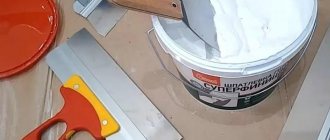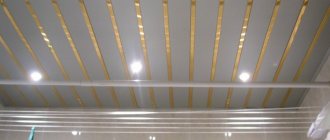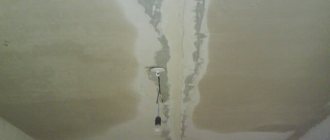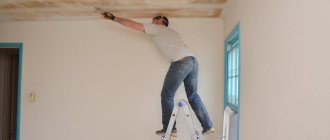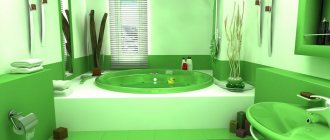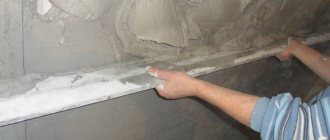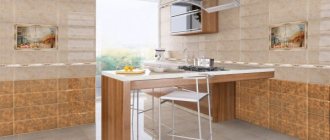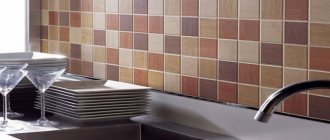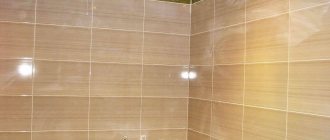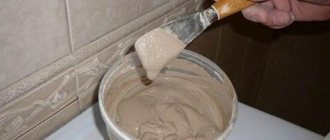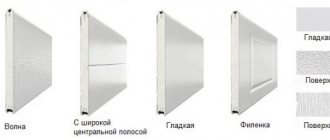Any person, when choosing materials for renovation of a bathroom, pays attention to the difference in the cost of regular tiles and porcelain stoneware. At the same time, they look almost the same. So why are porcelain tiles so much more expensive? It's all about the production technology and the raw materials that are used.
Porcelain stoneware is one of the most wear-resistant materials for repairs and construction. From the name you can understand that real natural granite is used in the production of this material. This rock determines the high resistance of porcelain tiles to various physical influences.
Once upon a time, such tiles were used mainly for cladding walls and floors in industrial workshops, but technology does not stand still and now we have the opportunity to buy different types of porcelain tiles for use in houses and apartments. Read the article to the end and you will learn about the types of porcelain stoneware, its unique properties and why this tile is one of the best materials for renovation.
Practical aesthetics: clad the walls with porcelain stoneware
Porcelain stoneware or ceramic granite is an artificial finishing material characterized by increased wear resistance and strength. Unlike ceramic tiles, which are nothing more than a fired clay plate, porcelain tiles are a composition produced by a special method, which includes not only clay, but also quartz sand and other components. More often it is used as a floor covering, but modern technologies make it possible to create aesthetic colors for wall cladding.
Marble bathroom and interior styles
Marble interior decoration looks impressive, but does not fit into all types of bathroom design. In order for such a design to look harmonious, it is necessary to adhere to one of two principles or both at once - luxury and/or environmental friendliness. In what style can you decorate a marble bathroom?
Marble bathroom design
1. Classic . In the classic style, absolutely all shades of marble are appropriate - from traditional white or black to fashionable pink and original green. This is also, perhaps, the only option that accepts a “total” stone finish – on the floor, walls and even furniture. The combination with forged metal parts (mirror frames or cabinet handles) and gilded decorations will add real luxury to the interior. The only limitation: this design is more suitable for spacious bathrooms.
Marble floor in a classic style bathroom
Marble finish in the bathroom with classic elements
Marble shower finish in a bathroom with classic style elements
Marble finishes are also suitable for the neoclassical style, which is close to the traditional classic, but here it is better to show a little restraint: leave the accent finish for only one element - the wall or floor, sink or countertop.
Imitation of marble in the decoration of a neoclassical style bathroom
2. Romance . For delicate bathroom interiors in a romantic style, a light marble design is ideal - in white, beige, smoky gray or pink. The sophistication of this design will be emphasized by the abundance of mirrors, rounded shapes of furniture, floral motifs and glass details - candles in glasses, jars for cosmetics, etc.
Romantic white marble bathroom with vintage elements
Tiling a pink marble bathroom in a romantic style
Imitation of pink marble with plaster in a romantic style bathroom
3. Art Deco . Imitation of dark marble looks great in this style: choose graphite gray, dark brown, emerald green or black. Complete the bathroom with dark wood cabinetry, gold or brass-toned fixtures and mirrors, and accent lighting. Since such dramatic shades visually narrow and darken the space, make sure there is good lighting. If the bathroom is initially quite small, leave the marble finish only for the floor or one of the walls (the best option is the space behind the bathtub or in the shower).
Black and white marble bathroom interior in Art Deco style
Art Deco style black marble bathroom
Marble mosaic tiles on Art Deco bathroom floor
4. Minimalism and Scandinavian style. For these popular solutions, similar recommendations apply: choose light colors of finishing materials with a marble texture (white or pale gray). As additional elements, give preference to light wood and laconic accessories - a mirror without a frame, sinks of simple shapes, sanitary equipment without unnecessary shine. It is better to keep the decor to a minimum - a graphic poster, a couple of candles or a compact plant in a ceramic pot (the latter is now the most relevant technique in bathroom decoration).
Marble finish in a minimalist bathroom
Imitation of white marble in a minimalist bathroom
Marble tiles in a Scandinavian style bathroom interior
5. Modern style. Bathrooms in modern style are characterized by the use of marble texture as small accents. Just one wall or even part of a wall, just the floor or a creative stone sink - it doesn't matter what you choose, but it should be the sole focus of your attention. Any shades are acceptable, but neutral ones are more often used - white-gray-black or beige-brown.
Marble bathroom finishing in modern eco-style
Decorating a marble bathroom in a modern style
Modern bathroom with imitation marble finishing
Practicality and characteristics
This material is one of the most practical finishing options because it has the following characteristics:
- Increased strength, including bending at kV. m., which allows installation on an uneven base.
- Wear resistance. Withstands prolonged mechanical impact, thereby minimizing the possibility of scratches and chips. Does not lose its shine even after prolonged use, and is resistant to ultraviolet exposure to sunlight. Does not react with chemicals.
- Frost resistance. Resistant to low temperatures.
- Thermal conductivity. When heated, it retains heat well.
- Fire resistance. Resistant to high temperatures and exposure to open fire, which allows for use in finishing fireplaces and stoves.
- Waterproof. The absorbing properties of porcelain stoneware are extremely low.
It is important to note that the material acquires increased strength indicators after laying and complete hardening of the adhesive mixture.
Porcelain tiles for bathroom floors and walls
Basically, the walls are decorated with polished or glazed porcelain tiles. It perfectly reflects light and expands the space in small rooms.
The well-known postulate that how many people, so many opinions, speaks for itself. There are a huge number of porcelain stoneware manufacturing plants. The quality of the products also varies greatly.
Accordingly, there is no consensus on this or that product either. Some people like to work with Russian materials, such as Italon Charme Extra tiles, some prefer European materials, and others choose Ukrainian ones. Therefore, we will simply consider the products that are most in demand on the Russian market.
Kerama Marazzj
More than 2000 titles have been developed - these are 12 collections of the Russian manufacturer. The only brand in the production of which European DRY PRESS technologies are used. This allows you to accurately style natural stone.
Positive traits:
- Relatively inexpensive cost,
- Good geometry, cuts well,
- Stylish, attractive design solutions,
- Rated as quite durable, resistant to mechanical shock.
Disadvantages: sometimes in collections the combination of colors or shades is poorly selected, there are deviations in length.
Fap Ceramiche
Expensive elite Italian porcelain tiles. It has been produced for many years at a plant in the city of Sassuolo, which naturally speaks of the quality of the material produced.
Designers have created almost 30 collections, the main emphasis being safety and environmental friendliness. The surface pattern is created to resemble natural stone, marble, wood.
Advantages:
- Excellent design solutions,
- Solid choice
- Quality products,
- Resistant to mechanical damage,
- The appearance is very respectable,
- Cuts well.
Among the shortcomings, it can be noted that sometimes the geometry of the elements is “lame”, there are deviations in size. Prices are quite high for the average consumer.
Keramin
Belarusian porcelain stoneware is created at the Minsk brick factory. More than 80 collections were released. Relatively low price, size range from 10x10 to 27.5x40 cm. In general, the quality is in accordance with the cost.
Pros:
- Large thematic selection,
- Interesting design patterns on the surface,
- High quality, durable products,
- Availability of interesting collections,
- Cuts well.
But: sometimes in collections there are discrepancies on the side of the tile of 1-2 mm, deviations in width and length.
Golden Tile
Ukrainian porcelain tiles from the Kharkov plant. The enterprise has organized the Italian bureau SRS, Poligraph, Tecnografica. More than 60 collections have been developed. The plant uses the latest special technologies for digital printing on surfaces.
The cost is low or medium - depends on the selected collection. In one batch there are discrepancies in penumbra or shades. Dimensional discrepancies are common.
Positive traits:
- The quality of porcelain tiles corresponds to the price (local raw materials are used),
- Wide choose,
- Great job from the designers.
Disadvantages: deviations on the side, there is a discrepancy in shades between different batches of the same collection.
When is wall cladding done with porcelain stoneware?
The use of ceramic granite in wall decoration is a relatively new trend in interior design. Porcelain tiles for wall cladding are popular because of their aesthetic properties, namely:
- similarity with eco-materials (marble, polished sandstone);
- durability and depth of color;
- geometric constancy of the pattern.
Finishing walls with ceramic granite places increased demands on the skill of the installer, as well as on the adhesive mixture and surface preparation.
“Marble” bathroom: which shade to choose?
The color of the finish must be chosen depending on what visual effect you want to achieve with the marble bathroom design:
Combination of marble tiles of various shades in the bathroom
- white – visually expands the space, “raises” the ceilings, makes the room brighter and goes with all colors, so it’s great for any bathroom (and for small and dark ones it will be the best solution);
White marble finish visually enlarges a narrow bathroom
Imitation of white marble in the interior of a small bathroom makes it lighter
White marble tiles in the bathroom interior
- gray is calm and discreet, helps to create a relaxing spa atmosphere, is universal, like white, but looks less sterile and much more cozy;
Imitation of gray marble in bathroom decoration
Combination of gray marble tiles and wood in the bathroom
Bathroom interior in dark gray marble
- black - adds luxury and drama, makes the interior “expensive”, but can narrow the space, so finishing with black marble tiles in a small bathroom will be inappropriate (as an option, use it as an accent, alternating with light shades);
Imitation of black marble in bathroom decoration
Black marble finish in the bathroom interior
Bathroom design with black marble tiles
- pink and beige – soft cool tones add tenderness and sophistication to the interior, which is ideal for a woman’s bathroom, while warmer and soothing cream shades are also good for a shared bathroom;
Imitation of beige marble in the bathroom interior
Imitation of pink marble in bathroom decoration
Combination of marble finishes in beige tones in the bathroom
- brown is an excellent option for monochrome bathrooms in fashionable earthy shades; such an interior helps to calm down and relieve stress at the end of the day;
Imitation of brown marble in bathroom finishing
Brown marble tiles in the bathroom
Brown tiles with imitation marble pattern in the bathroom
- green is an unusual option that is more suitable for spacious bathrooms (a rich dark color can visually narrow the space), and in small ones it is better to use it as an accent that will introduce an element of eco-style and a resort “marine” mood.
Large format green marble tiles in the bathroom
Decorating a bathroom with large-format green marble tiles
Imitation of green marble in bathroom decoration
Laying porcelain tiles on the wall with your own hands
Using ceramic granite in finishing work causes more difficulties than tiles, so novice craftsmen should carefully familiarize themselves with the subtleties and nuances of the process.
It is better for non-professional finishers to use material with a width of 25 to 45 cm and a length of up to 75-80 cm. Smaller tiles are difficult at the adjustment stage, and larger ones will require special equipment for temporary fastening and gripping.
Not every type of surface is suitable for cladding. The base must have additional load-bearing capacity commensurate with the total weight of the material and the adhesive layer and a high degree of stability without a tendency to change under the influence of external factors. The adhesive properties of the surface are also important, but this problem can be solved by priming.
Adhesive for porcelain tiles on the wall: what should it be?
The adhesive mass for ceramic granite is characterized by increased elasticity and adhesion. The choice of glue for the job depends on:
- type and properties of the base;
- operating conditions.
In the case of finishing an external wall, the adhesive must have increased frost resistance and be resistant to temperature changes. Considering the large weight of the material, adhesion indicators are extremely important, especially when working on smooth substrates.
Experts recommend the following brands of adhesive mixture:
- Vetonit Granite Fix from the French company Weber (manufactured in Russia). It is used for fastening the material to horizontal and vertical surfaces; it is characterized by increased frost resistance, which allows it to be used for external cladding. It has increased adhesion to materials with weak absorbency: brick and concrete. In case of interior work, installation on plasterboard and plaster is possible.
- Ceresit CM 14 Extra has German quality and durability standards. It has a cement-mineral base with the inclusion of polymer modifying components. Suitable for working with ceramic granite of any weight. It is characterized by increased frost and heat resistance.
- Hercules GM -55 is a specialized adhesive mixture for porcelain tiles. Suitable for external and internal finishing works. Has high adhesion rates.
How to glue large porcelain tiles to walls
Laying tiles of any size follows the same principles.
But when working with large tiles, the requirements for the surface increase: it must be perfectly flat, since any differences will be very noticeable and will negatively affect the quality of the masonry. When working with tiles larger than 600×600, the wall must be measured and all protruding irregularities must be ground off, and the surface must be carefully primed.
The adhesive mixture is applied to the tiles with a special spatula, but you shouldn’t rely on it: the actual layer of adhesive under the tile still does not exceed 2-3 mm. Therefore, maximum attention is paid to how flat the base is for the work. For additional distribution of the adhesive mixture under the slabs, tapping with a hammer on the protruding parts of the material is used.
For additional strength when working with large-sized ceramic granite, glue is applied to both the tile and the base.
Types of material
There are many types of porcelain wall tiles on sale. Let's consider the main ones:
- With polished finish . It is processed during the production process with an abrasive compound. This type of porcelain tile has a glossy reflective surface, with a deep texture and rich detailing. It is not recommended to be used for floor finishing, because... it's very slippery. But it is best suited for walls and looks elegant and expensive.
- Semi polished type . The material is used exclusively for wall mounting. It has a mixed structure, where the glossy surface alternates with matte.
- Matte . Used for façade wall decoration. It is the most popular type of porcelain tile. Its cost is cheaper than other varieties of this material. It has high wear resistance and resistance to negative environmental factors. Produced without applying additional layers.
- Polished (satin) . It is highly resistant to stains. Before heat treatment, the tiles are coated with special salts. When heated, they melt, forming a shiny surface that does not require additional sanding. Such slabs have a silky-matte appearance and a velvety structure. They feel soft to the touch and look very elegant.
- Mosaic . There are two types: matte and glossy.
We recommend: Mineral wool insulation - dimensions, which is better, characteristics. What and how to insulate using mineral wool
This type of porcelain tile is distinguished by its labor-intensive installation. The small size of the slabs requires much more installation time.
Wall decoration with porcelain stoneware: practical tips
The basic principles of working with porcelain stoneware are the same as when working with tiles. But there are a number of differences that you need to familiarize yourself with before starting work.
- When purchasing, you need to pay attention to the end part of the material. An indicator of quality is the case when it does not differ from the front surface of the tile except for the structured and satin varieties.
- Cerogranite is difficult to cut. At home, a grinder is often used. If finishing involves a large volume of cut tiles, it is better to order this service from specialists with the necessary equipment. This will save time, effort and nerves, and will also protect against possible damage to the material.
- To temporarily secure the laid rows, you can use masking tape.
- Some craftsmen, in exceptional cases, attach porcelain tiles with self-tapping screws - in cases where the caps are hidden, for example, behind furniture. This option is justified as an alternative to laying large tiles on an adhesive mixture, but from the point of view of aesthetics and quality, this option loses.
Wall decoration with porcelain tiles is less common than conventional ceramic tiles. At the same time, only the laying of large-sized plates is more complicated. And the similarity of porcelain stoneware with noble finishing materials of natural origin allows it to be used for the implementation of sophisticated and original design projects.
What to put it on
Since porcelain stoneware has very low hygroscopicity, laying it on a regular cement-sand mortar is a waste of time and money. Water is not absorbed into the surface of this material, and the tile practically does not stick. It is with this adhesive composition that the finish “bounces off”. There is almost no adhesion with the solution.
It is better to lay porcelain tiles using special glue
For heavy facing materials, special glue is made with a large number of polymer additives. This composition has many times greater adhesive ability, so that even with very low hygroscopicity, porcelain stoneware holds well. You should not use cement-sand mortar for installation. In this case, there is a high probability that the tiles will separate from the floor or walls during operation. You will have to take it out, hollow out the mortar, prime it and set the porcelain tiles on a special glue.
Properties of porcelain stoneware
Distinctive properties of porcelain stoneware
Finishing a bathtub with porcelain stoneware is the right and thoughtful solution for every user. Possessing a number of excellent qualities, the cladding will serve for a long time, maintaining its appearance and delighting the buyer with the freshness of its colors.
Tiles for children's bathroom. Recommendations for choosing tiles and an overview of design ideas
- The coating reduces the risk of electric shock (if there is a washing machine and other appliances in the bathroom) to zero;
- Bathroom tiles made of porcelain stoneware are abrasion-resistant, do not fade, and are durable and resistant to chemicals. This means that even if you spill household chemicals on the floor, you will not get a faded stain on the coating;
- Impact resistance and wear resistance are another quality necessary for long and flawless operation of the finishing material. Porcelain stoneware tiles go through the firing stage at a temperature of at least 1250-1300C, and come under a heavy, powerful press, which leaves no air in the body of the tile and completely sinteres all the elements. It takes a lot of effort to break, chip or chip the finish;
- Frost resistance is a quality that tiles have. Therefore, if there are unused tiles left, feel free to lay the floor on a balcony or loggia.
Suitable types of load-bearing foundations
Not every wall and partition can be lined with porcelain stoneware. The main factor in suitability for this type of finishing is the presence of additional load-bearing capacity comparable to the weight of the tile and adhesive layer. Additionally, the stability of the base should be taken into account - both seismic stability and the tendency of the material itself to linear expansion under the influence of external causes play a role here. The third aspect of substrate suitability is adhesion, but this can almost always be improved with additional preparation.
In fact, all enclosing structures have sufficient load-bearing capacity. The exception is walls made of sandwich panels, also framed with sheet cladding without internal stone lining. An additional limitation for laying porcelain stoneware is the temperature regime of the building: the temperature range inside must be maintained as determined by the adhesive manufacturer, on average it is from +10 °C to +35 °C.
Separately, it is worth mentioning false walls covered with gypsum fiber board or aquapanel. Their flatness, stability and adhesion do not raise any questions, but there are challenges in ensuring sufficient load-bearing capacity. Porcelain stoneware requires the construction of a frame subsystem from a profile with a metal width of more than 0.6 mm and an increased density of the rack parts - less than 40 cm. The introduction of ceiling profiles (CD) as frame racks is unacceptable. For sheathing, you should use only moisture-resistant types of gypsum plasterboard and gypsum board with a width of more than 16 mm with a fastening density of more than 30 screws per m2.
How to style without a seam
Please note that all manufacturers on the market produce tiles for laying with a joint. This is a so-called buffer that protects the laid porcelain tiles from damage.
The laying of porcelain tiles without seams is carried out at the request of the customer without a guarantee, as the technology is violated.
Seamless installation on standard porcelain stoneware is not provided by the manufacturer.
However, it can be done on a perfectly flat surface, in a building with no shrinkage and a constant room temperature. It is believed that the ideal material is large format tiles. Although porcelain tile is solid, installing it without a joint can cause severe stress in the installed material, resulting in heaving or cracking. Creaking may be observed when walking. Try to tell the customer about the pitfalls of this installation technology, so that he will think a hundred times about how to lay porcelain tiles without seams and with problems, or porcelain tiles with seams and without problems. Now you can definitely choose and execute how to lay porcelain tiles on the floor.
Use special knee pads. This will save not only clothes, but also knees
